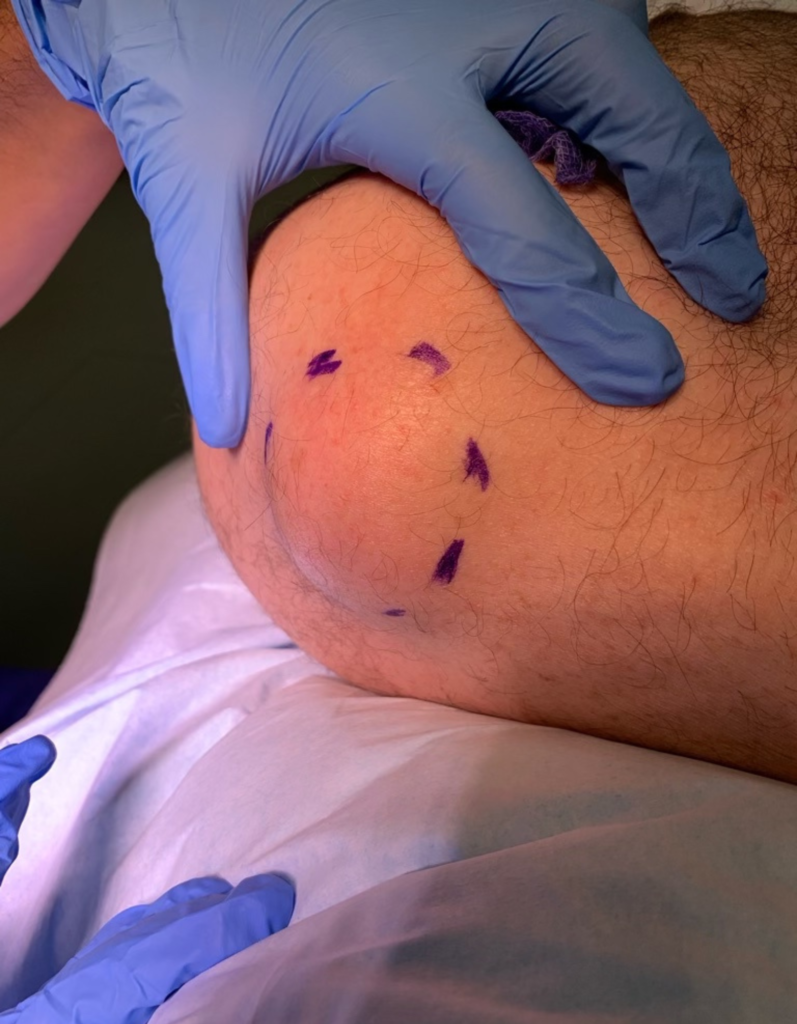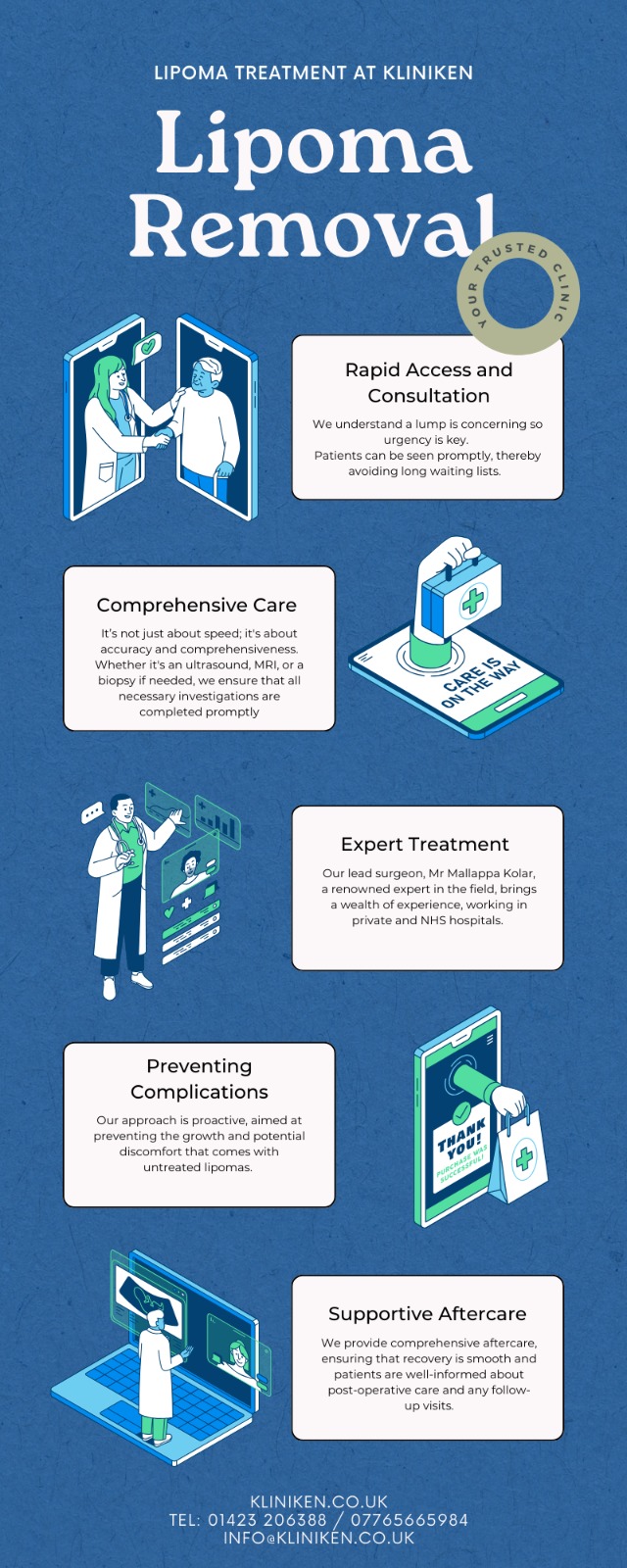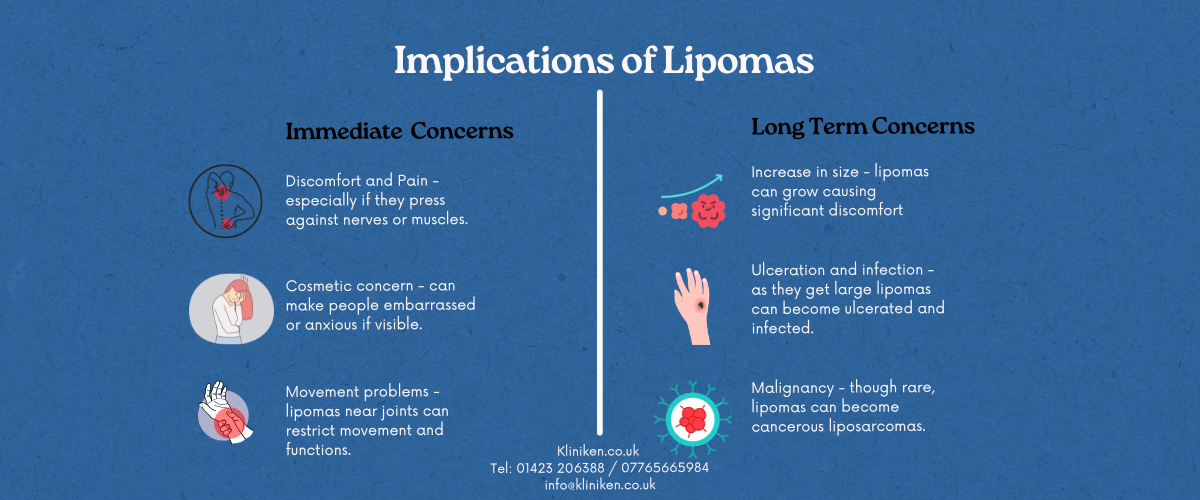Stop Ignoring That Lump!
Here’s Why Quick Action on Lipomas is Key
Lipomas, those benign lumps of fat beneath the skin, are often dismissed as mere cosmetic nuisances. However, understanding the broader implications of these growths is crucial. This article delves into the unseen consequences of neglecting lipomas, emphasising both health and financial repercussions.
Understanding Lipomas
A lipoma is a lump of fatty tissue located just under the skin. Imagine a small, soft, and often movable bump that is generally not painful. These growths are benign, which means they are not cancerous and rarely pose a serious health threat.
What Does a Lipoma Look and Feel Like?
A lipoma can be identified by its soft, rubbery texture. It’s usually painless and can be moved slightly under the skin when pressed. Most lipomas are small, about the size of a pea, but they can grow to several centimetres in diameter over time.

What Causes Lipomas?
The exact cause of lipomas isn’t fully understood, but they are thought to be related to genetic factors, as they often run in families. They are more common in middle age, suggesting age may play a role. Contrary to popular belief, lipomas are not typically caused by obesity or weight gain; instead, they seem to arise from fat cells that grow abnormally

How Do a Lipomas Progress?
To understand why lipomas get bigger, it’s essential to delve into their physiological makeup and how they grow. Physiology and Growth of Lipomas
- Origin and Composition: Lipomas are composed of adipocytes, the cells that make up fatty tissue in the body. They originate from a small cluster of these adipocytes that begin to proliferate more than the surrounding fat cells.
- Cell Proliferation: The growth of a lipoma is primarily due to the increase in the number of fat cells (adipocytes) within it. This process, known as hyperplasia, is where the cells divide and multiply, causing the lipoma to grow in size.
- Encapsulation: Unlike normal fat tissue, which is distributed evenly, the fat cells in a lipoma are contained within a thin, fibrous capsule. This encapsulation can sometimes contribute to the lipoma’s growth, as it creates a distinct mass separate from the surrounding tissue.
- Blood Supply: As a lipoma grows, it develops its own blood supply to sustain the added cells. This increased blood flow can further facilitate the growth of the lipoma by providing the necessary nutrients and oxygen to the proliferating fat cells.
- Growth Factors and Hormones: The growth of lipomas may be influenced by various growth factors and hormones within the body. For instance, an imbalance in hormones or an increase in specific growth factors could potentially stimulate the growth of lipomas.
- Genetic Factors: In some cases, genetic predispositions might play a role in the growth of lipomas. Certain genetic mutations or hereditary conditions can make individuals more prone to developing larger or multiple lipomas.
- Physical Space and Pressure: The growth of a lipoma is also subject to physical constraints. The pressure from surrounding tissues can influence its shape and growth pattern. Over time, as the lipoma slowly expands, it can displace nearby tissue
Why Do Some Lipomas Grow Larger Than Others?
The rate and extent of growth can vary significantly from one lipoma to another. Factors such as the location of the lipoma, the individual’s overall health, genetic predispositions, and possibly lifestyle factors (like diet and exercise) might influence how much and how quickly a lipoma grows. Regular monitoring of a lipoma for changes in size, shape, or sensation is essential, and any significant changes should be evaluated by a healthcare professional. Understanding these aspects is crucial, in Yorkshire and most of the UK, there are multiple pathways via either NHS or private healthcare options for managing these growths.
Implications of Lipomas While lipomas are generally harmless, they can present immediate concerns in certain scenarios:
- Discomfort and Pain: Although usually painless, lipomas can become uncomfortable if they grow large or are situated in areas where they press against nerves or muscles.
- Cosmetic Concerns: For many, the appearance of a lipoma, especially if it’s in a visible area like the neck or arms, can be a source of self-consciousness or distress.
- Movement Restriction: Lipomas located near joints or on limbs may impede movement, especially if they grow to a substantial size. Long-Term Health Implications Over time, untreated lipomas can lead to more significant issues.

Long-Term Implications
- Growth and Size Increase: While slow-growing, some lipomas can reach a size that causes significant discomfort, necessitating medical intervention.
- Risk of Infection or Ulceration: Rarely, a large lipoma might become infected or ulcerated, leading to more severe health complications.
- Potential for Malignant Changes: Though very rare, there is a small risk that a lipoma could develop into a cancerous liposarcoma. This is more likely if the lipoma is rapidly growing, painful, and firm.
Risk Factors for Complications
Certain factors may increase the risk of complications from lipomas:
- Genetic Predisposition: Individuals with a family history of lipomas may be more prone to developing larger or multiple lipomas.
- Age Factor: People between the ages of 40 and 60 are more likely to develop lipomas, though they can occur at any age.
- Certain Medical Conditions: Conditions like adiposis dolorosa or Gardner syndrome can increase the risk of developing multiple lipomas.
Prevalance of Immediate and Long term Implications
The immediate and long-term complications of lipomas are relatively rare. Most lipomas remain small and asymptomatic. However, it’s estimated that a small percentage of cases might experience discomfort or cosmetic issues, leading to the need for treatment. The risk of a lipoma becoming cancerous is very low, but it underscores the importance of monitoring any changes in size, shape, or feel. Early awareness and intervention can significantly reduce the risk of experiencing these more severe outcomes.
In the NHS framework, treating a lipoma early is usually straightforward and cost-effective. But as the pressure on the NHS grows, it is becoming increasingly hard to get an appointment to have it looked at and removed.
However, delaying treatment can lead to more complex medical procedures later, incurring higher costs, especially for those seeking private healthcare. The economic wisdom of early treatment is clear: it prevents the escalation of both medical intervention and associated costs.
Case Study: Emma’s Neck Lipoma
One of our patients, Emma, a 38-year-old graphic designer from Leeds, first noticed a small, pea-sized lump on the back of her neck. Initially, it was neither painful nor visible, so she put off seeking medical attention, attributing it to a harmless quirk of her body.
Physical Escalation:
Over the next two years, Emma’s life became increasingly impacted by the growing lipoma. What started as a mere inconvenience gradually became a constant source of discomfort. The lipoma grew to the size of a golf ball, becoming not just visible but also pressing against nerves in her neck. This pressure led to frequent headaches, a persistent dull ache in her neck, and occasional sharp pains that would shoot down her spine, disrupting her focus and sleep.
Emotional Toll:
The physical discomfort was just one part of Emma’s struggle. As the lipoma became more noticeable, she grew self-conscious about her appearance. She started wearing scarves and high-collared shirts year-round, even in warm weather, to hide the lump. This change in her appearance and the constant effort to conceal the lipoma took a toll on her self-esteem. She found herself withdrawing from social situations, declining invitations to outings where she couldn’t easily hide her neck.
Delayed Treatment and Its Consequences:
When Emma finally sought medical help at Kliniken, the lipoma required a more complex surgical procedure than would have been necessary had she addressed it earlier. The surgery carried out by Mr Kolar involved careful excision to avoid nerve damage and ensure cosmetic restoration of the affected area. The recovery was longer than typical lipoma removals, involving physical therapy to regain full neck mobility.
Post-Treatment Reflections:
Post-surgery, Emma experienced relief from the physical pain and a gradual return of her self-confidence. However, she often reflected on how the delay in seeking treatment had unnecessarily prolonged her discomfort and emotional distress.
Kliniken Lipoma Treatment Journey
Rapid Access and Consultation:
At our practice, which is based in Harrogate, North Yorkshire, we understand the concerns and urgency that come with discovering a lipoma. That’s why we prioritise quick access to our services. New patients can expect prompt appointments, minimising the wait time to be seen by a specialist. Our efficient scheduling ensures that from your first contact, you’re on a fast track to receiving expert care.
Comprehensive and Speedy Investigations:
Upon consultation, our team, equipped with state-of-the-art diagnostic tools, swiftly conducts thorough investigations. This approach is not just about speed; it’s about accuracy and comprehensiveness. Whether it’s an ultrasound, MRI, or a biopsy if needed, we ensure that all necessary investigations are completed promptly, aiding in devising the most effective treatment plan without delay.
Expert Treatment by a Renowned Surgeon:
Our lead surgeon, Mr Mallappa Kolar, a renowned expert in the field, brings a wealth of experience, having successfully performed hundreds of lipoma cases every year. This level of expertise not only assures quality care but also enhances the precision and efficacy of the treatment. Patients benefit from the latest surgical techniques tailored to their specific needs, ensuring the best possible outcomes with minimal scarring and quick recovery.
Focused on Preventing Complications:
By addressing lipomas promptly and effectively, we significantly reduce the risk of complications that can arise from delayed treatment. Our approach is proactive and aimed at preventing the growth and potential discomfort that comes with untreated lipomas. Patients can rest assured that they are in capable hands, receiving care that prioritises their health and well-being.
Supportive Aftercare:
Post-treatment, our commitment to patient care continues. We provide comprehensive aftercare, ensuring that recovery is smooth and patients are well-informed about post-operative care and any follow-up visits. Our team remains available to address any concerns or questions, ensuring a supportive and reassuring environment.
Cost of Treatment
Click on the link below to take you to our page about lipomas where we have price ranges. For an accurate quote we will need to see you for a consultation.
https://kliniken.co.uk/index.php/procedure-pricing/#skin
Call us on 01423 26388 or email us info@kliniken.co.uk or text us on 07765665984 to learn about the next steps.
Conclusion: Understanding Lipomas and Embracing Timely Intervention
In closing, it’s crucial to re-emphasise that a typically benign lipoma is a tumour. This fact alone can make its presence unsettling and warrants attention. While most lipomas are harmless and grow slowly, the potential complications, though rare, can be serious. Ignoring a lipoma not only risks physical discomfort but can also lead to situations requiring more complex medical intervention.
At Kliniken, in North Yorkshire is dedicated to ensuring that these risks are minimised. With the expertise of our skilled surgeon, Mr Kolar and our commitment to rapid assessment and treatment, we stand at the forefront of offering peace of mind to our patients.
We understand the anxiety that any form of tumor, including a lipoma, can cause. Our streamlined process from consultation to treatment is designed to swiftly address your concerns, allowing you to return to your best life without the shadow of worry.
Remember, the journey of treating a lipoma, when started early, is typically straightforward and effective. Delaying treatment not only prolongs uncertainty but can also lead to avoidable complications. In the interest of your health and well-being, we encourage anyone noticing a lipoma to seek consultation sooner rather than later. By doing so, you take an important step towards ensuring your health and maintaining the quality of life you deserve.


